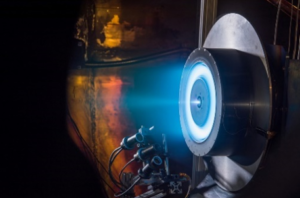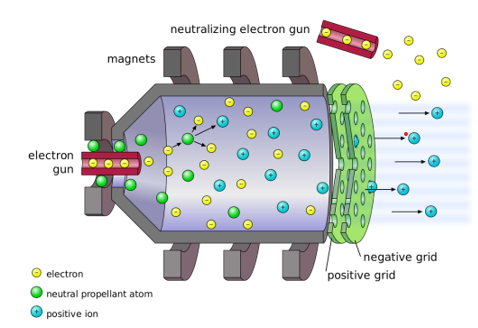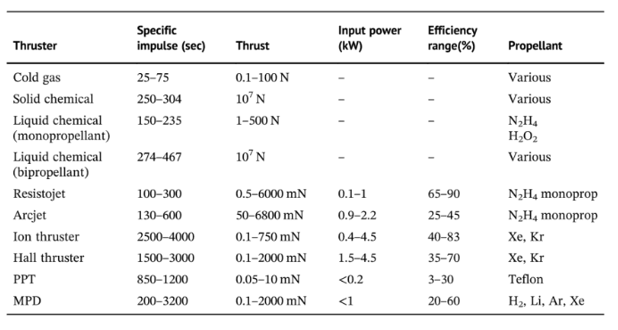When you think about electric propulsion, what thoughts come to your mind? The most likely scenario is that the first associations are established with electric cars and bicycles. Still, the concept of electric propulsion extends beyond automobiles to encompass various uses within the aerospace sector.
In aerospace, RC airplanes and electric UAVs are often seen as a form of electric propulsion, using batteries and motors instead of traditional combustion engines.
So, what is the significance of “Electric Propulsion” in the field of aerospace?
An Introduction to Electric Propulsion
Electric propulsion technology utilizes different electricity principles to propel aircraft or spacecraft without relying on traditional chemical combustion methods to make them efficient and environment-friendly. Electric propulsion is not commonly implemented in aircraft (excluding small UAVs and RC planes). Therefore, electric propulsion is mainly linked to space technology. Research in this field focuses on producing thrust with high exhaust velocities to enhance Specific Impulse (Isp) and reduce the need for costly and heavy onboard propellant.
This article is aimed at an audience with only a basic understanding of propulsion, so it explains the fundamental concepts necessary to understand the basic idea and importance of EP technology. It also explains the development of EP technology, its comparison to traditional propulsion systems in space exploration, and its use in aircraft and spacecraft. We explore the mechanics of electric propulsion, detailing its different forms, and give a summary of current initiatives advancing this innovative technology. By comparing and exploring EP, our goal is to emphasize its increasing influence on the future of aviation and space exploration.

Ion Thruster (Source:[1])
Specific impulse (Isp)
Specific Impulse measures how efficiently a rocket utilizes fuel. Think of it like this: a tiny balloon moves rapidly but doesn’t last long, like rockets with low Isp which consume fuel quickly. A larger balloon has a slower speed but can cover greater distances, analogous to high Isp rockets that use fuel more effectively. Greater Isp results in covering more distance using less fuel, a crucial factor for long space missions.
In technical terms, specific impulse is defined as the amount of thrust generated for each unit of propellant weight flow. It is an essential measure of rocket engine performance. It measures how efficiently propellant is transformed into thrust. The specific impulse is typically expressed in seconds (represents how long the rocket can produce thrust based on a given propellant) and can be determined using the equation:

Where:
- Isp = specific impulse (seconds).
- F = thrust produced by the engine (newtons).
- m(dot) = mass flow rate of the propellant (kilograms per second).
- go = standard gravitational acceleration (approximately 9.81 m/s²).
Thrust vs. Specific Impulse: How do they differ?
People often mix up thrust and specific impulse when discussing rockets, even though they have distinct roles in rocket performance.
Thrust: The force needed to push the rocket upwards during takeoff.
Isp: Evaluates fuel economy; crucial for extended space missions.
Thrust matters more for short missions carrying heavy loads. Isp is crucial for reducing fuel usage during extended missions. The table below assists in determining whether to emphasize thrust or Isp according to mission requirements (time, cost, weight, etc.).

The table below gives the approximate time for different combinations of Isp and thrust.

Why Electric Propulsion?
Conventional rocket propulsion uses chemical reactions to speed up the propellant, leading to a lower specific impulse and reduced efficiency. For instance, while a chemical rocket engine expels gas at approximately 5 km/s, an ion engine can expel single atoms at velocities reaching 90 km/s, significantly enhancing efficiency.
When it comes to propulsive power, a chemical rocket engine generates significantly more thrust than an ion engine (which usually has thrust measured in millinewtons). This causes electric propulsion to be ineffective in Earth’s atmosphere, making it unable to launch rockets.
Nevertheless, electric propulsion systems are utilized in the space industry for extended missions, orbit adjustments, station-keeping, and orbital alterations in space because of their higher specific impulse (Isp).
The delta-v needed (Change in velocity) to maneuver a rocket to a higher or lower orbit, depends on the specific impulse of the propulsion system.
A Back-of-the-Envelope Calculation
Both chemical and electric propulsion systems with an exhaust velocity of 3 km/s were assessed in a situation where a 1000 kg payload needed a delta-v of 6 km/s. The chemical rocket engine, with an Isp of 306 seconds, requires about 7389 kg of total initial mass, which includes 6389 kg (86% of total mass) of propellant. On the other hand, the electric propulsion system, which has an Isp of 3060 seconds, needs the same starting mass but only around 639 kg (8.6% of total mass) of propellant.
From the above calculations, using electric propulsion in rockets decreases the total mass, resulting in a smaller rocket size that needs less thrust for take-off and makes it cost-efficient. This shows that more fuel is required by chemical propulsion, while electric propulsion is more fuel-efficient but results in a longer time to reach the desired velocity.
Tsiolkovsky Rocket Equation
An important equation governing the rocketry real is the Ideal Rocket Equation, given below:

Where:
- Δv = change in velocity needed for a maneuver.
- Ve= specific impulse.
- g = standard gravitational acceleration (approximately 9.81 m/s²).
- mo = initial mass of the spacecraft (with fuel).
- mf = final mass after the fuel is depleted.
These equations explain how the engine’s efficiency (Isp) and the ratio of the spacecraft’s mass before and after propellant burn determine the change in velocity (Δv). Electric propulsion can attain high delta-v because of its high Isp, but it requires significantly more time compared to chemical propulsion due to its lower thrust.
The specific mission requirements determine the choice of a propulsion system. Electric propulsion is a phase of rocket flight (having better performance in space), but we cannot escape the Earth’s atmosphere without chemical propulsion.
Chemical rockets are usually preferred for missions of short duration. On the other hand, electric propulsion is the more desirable choice for interplanetary missions because it offers a higher specific impulse.
A Brief History of Electric Propulsion in Space
When discussing aerospace, electric propulsion is typically connected with space propulsion. The primary concept is to use electric energy to accelerate ions, using electrothermal, electrostatic, or electromagnetic forces. In electric propulsion systems, inert gases are ionized and accelerated, leading to much higher exhaust speeds compared to conventional techniques.
“Electric Propulsion (EP) is a class of space propulsion
that utilizes electrical power to accelerate a propellant
through various electrical and/or magnetic methods.”
– European Space Agency (ESA).
In 1911, Konstantin Tsiolkovsky proposed the use of electric propulsion for space vehicles. Previously, Robert Goddard had recorded the possibility in his personal notebook.
Electric rocket engine development began on May 15, 1929, led by the Soviet Gas Dynamics Laboratory (GDL). The initial electrothermal rocket engine was created in the early 1930s under Valentin Glushko’s guidance. Electric rocket engines were used on the Voskhod 1 spacecraft and the Zond-2 Venus mission in the 1960s due to the continuous improvement of this early GDL technology.
Major electric propulsion research initiatives were launched in the 1960s at NASA’s Glenn Research Center, Hughes Research Laboratories, NASA’s JPL, and several Russian institutes to advance technology for satellite station-keeping and deep-space prime propulsion applications. In the early 1960s, the first experimental ion thrusters were sent into orbit by the United States and Russia, using cesium and mercury for propulsion.
In 1973, Tony Martin, an American theorist, proposed using an electrically powered nuclear reactor for Project Daedalus’ interstellar propulsion, but the concept was discarded due to issues with thrust profile, heavy equipment needed for converting nuclear energy to electricity, and slow acceleration leading to a century-long journey to reach the desired speed.
Ion thrusters and Hall thrusters have experienced significant growth in the past decade due to their utilization in communications satellites to decrease the amount of fuel needed for station keeping and orbit insertion.
Escaping a Super-Sized Earth: Mission Impossible?
Here’s a fun fact: If the size of Earth were tripled, the gravitational force would be approximately nine times greater than it is now. This would lead to a significantly higher escape speed, probably exceeding 30 km/s instead of the current 11.2 km/s. No current chemical propulsion system is capable of producing sufficient propulsion to counteract this increased gravitational force, due to the excessively large amount of required fuel mass. Therefore, it would be extremely difficult to escape Earth’s atmosphere using current technology, which would greatly restrict space exploration.
Role of EP in Small-Scale UAVs and Limitations in Large-Scale Aircraft
The power systems in RC planes and smaller UAVs usually rely on batteries because of their limited endurance and lightweight. This technology is becoming more popular in bigger planes to lessen engine noise, boost efficiency, and promote environmental sustainability.
The question may arise: Why isn’t electric propulsion common in larger aircraft, and why is it mostly seen in smaller planes like RC models?
The solution can be found in the constraints of current battery technology. Batteries are heavy and large, causing challenges in effectively providing power to large airplanes. Despite advancements, current top batteries would add a lot of weight to an aircraft, using up energy that could be used for transporting passengers and goods. Moreover, including the batteries causes more drag (Large batteries increase space requirements, leading to a larger aircraft design), which in turn lowers efficiency even more.
To address these difficulties, NASA is developing the M-SHELLS project (Multifunctional Structures for High-Energy Lightweight Load-bearing Storage). The goal of the project is to create innovative materials that have the dual functionality of storing energy and being a part of the aircraft’s structure. These materials need to possess the same strength as traditional construction materials, as well as have the ability to store high energy levels and charge and discharge quickly. The objective is to decrease or remove the necessity of individual batteries, ultimately reducing the extra payload in electric airplanes. The team aims to improve energy storage and utilization efficiency by combining battery and supercapacitor technology [2].
While fully electric propulsion for large planes remains out of reach for now, hybrid electric planes, which combine electricity with jet fuel, offer a promising alternative.
“If electrified propulsion really works out for large aircraft, it could be as big a change as the transition from piston-engine propeller planes to jet engines.”
-Jim Felder, NASA aerospace engineer
NASA is currently working on X-57 for the purpose of utilizing it as an electric-powered aircraft to further progress this effort. Through the utilization of “Distributed Electric Propulsion (DEP),” which involves incorporating several electric motors along the wings of the aircraft to closely match the propulsion system with the structure of the airplane. It is anticipated that this method will boost productivity, lower expenses, and improve safety.

X-57 (Source:[3])
In October 2019, NASA received the initial X-57 configuration out of three at Armstrong Flight Research Center for testing. Referred to as “Modification II (Mod II)”, this iteration will be subjected to ground tests, then taxi tests, and finally flight tests [3].
A key aim of the X-57 project is to help establish certification standards for the emerging market of electric aircraft, such as urban air mobility vehicles. These vehicles rely on advanced distributed electric propulsion systems, highlighting the need for standardized guidelines to ensure their safe and efficient operation.
Types of Electric Propulsion
Different types of electric propulsion are given below and are discussed one by one.

-
Electrothermal Propulsion
Electrothermal propulsion uses electrical energy to heat up a propellant and eject it at high speed to generate thrust. Heat is applied to the propellant either through electrical resistance or arc discharges, leading to the production of force from the expansion of hot gas.
Working Principle
The electrical energy is transformed into heat energy, which warms the propellant (typically a gas such as hydrogen, xenon, or ammonia). The warmed propellant expands and is propelled through a nozzle, just like traditional chemical rockets, resulting in a high exhaust velocity, which pushes the rocket forward.
Example: Resistojet, arcjet.

Schematic of Resistojet (Source:[4])
An electric heating element is used to heat a gaseous fuel, which is then injected into a combustion chamber of resistojet. The chamber warms up the fuel. The temperature and pressure are raised by electric heater. The expanded gas flows out of a nozzle, transforming heat energy into motion energy, and generating thrust as it leaves. The main source of thrust comes from the gas expanding due to heat, not chemical reactions.
-
Electrostatic Propulsion
Utilizing electrostatic fields to propel ions to generate thrust is the basis of electrostatic propulsion. Ions are produced and sped up by electric fields in these systems to produce fast ion streams, leading to the generation of momentum.
Working Principle
Ions, usually charged particles, are sped up using an electric field. A field is created by a voltage difference between two electrodes, causing ions to be expelled from the engine, resulting in thrust.
Example: Ion thrusters, Hall thrusters.

Schematic of gridded electrostatic ion thruster (source: [5])
Grid ion thrusters work by injecting a gas, such as xenon, into an ionization chamber, where emitted electrons interact with neutral gas atoms to produce positive ions and free electrons. An encompassing magnetic field boosts ionization effectiveness by enclosing electrons and improving collision opportunities. The next step speeds up the positive ions by passing them through two grids with opposite charges, creating a voltage difference that pushes the ions outward, generating thrust. To prevent the spacecraft from accumulating a net positive charge, an external electron beam is employed to counterbalance the ion stream, ensuring the success of extended space expeditions.
-
Electromagnetic Propulsion
Magnetic fields and electric currents are used in electromagnetic propulsion to accelerate plasma, a hot, ionized gas, in order to create thrust by quickly propelling the plasma out of the thruster.
Working Principle
Electromagnetic propulsion is the process of speeding up charged particles by utilizing the Lorentz force, which is produced when a magnetic field interacts with an electric current within the plasma.
Examples: Magnetoplasmadynamic (MPD) Thruster, Pulsed Plasma Thruster (PPT), Pulsed Inductive Thruster (PIT).

Schematic of PPT (Source:[6])
A pulsed plasma thruster functions by utilizing short bursts of electrical discharge to wear down a solid propellant, transforming it into plasma via a high-energy plasma arc. The ionized plasma is accelerated by Lorentz force (JxB) in the thruster by interacting with an external magnetic field, propelling the ions at high speeds. Thrust is created by ejecting plasma in accordance with Newton’s third law of motion, and the level of thrust is affected by the frequency of discharge pulses that last only for tens of microseconds to prevent damage. Some of the operating parameters of chemical and electric thrusters are summarized in the table below.

(Source:[6])
Current Advancements in electric propulsion
Electric propulsion technology is advancing significantly in different space exploration projects. Listed below are a few of the main projects currently being developed which highlight the potential and application of electric propulsion systems.

What Next?
Electric propulsion is a promising emerging field in aerospace technology that provides notable efficiency and inventive features for spacecraft. As we progress in research and development, we can anticipate upcoming innovations that might revolutionize space exploration and air travel. This article provided a basic overview, but upcoming discussions will delve into the mathematics and more complex ideas of electric propulsion, demonstrating its potential to revolutionize interplanetary travel.
At Mach Alpha, our propulsion engineers are committed to providing creative solutions and expert advice to electric propulsion enthusiasts. Our main goal is to develop innovative electric propulsion technologies for aerospace to improve sustainability and eco-friendliness in the aviation industry.
References
[1] “Ion Thrusters Keep Satellites Going and Going | NASA Spinoff,” Nasa.gov, 2024. https://spinoff.nasa.gov/Ion_Thrusters_Keep_Satellites_Going_and_Going
[2] “Electric airplanes (batteries included),” science.nasa.gov. https://science.nasa.gov/aeronautics/green-aviation-tech/electric-airplanes-batteries-included/
[3] “Electric Propulsion Technologies – NASA,” Dec. 07, 2021. https://www.nasa.gov/centers-and-facilities/armstrong/electric-propulsion-technologies/
[4] “Electric propulsion for satellites and spacecraft”, Established technologies and novel approaches – Scientific Figure on ResearchGate. Available from: https://www.researchgate.net/figure/Schematic-of-electrothermal-and-electromagnetic-thrusters-a-resistojet-b-arcjet_fig3_300001581 (accessed 8 Oct 2024)
[5] “Electrostatic Propulsion Systems,” An Analysis of Current Propulsion Systems, 2024. https://currentpropulsionsystems.weebly.com/electrostatic-propulsion-systems.html (accessed Oct. 08, 2024).
[6] Goebel, Fundamentals of Electric Propulsion, Second Editio N. Wiley-Blackwell, 2024.
[7] “NEXT Provides Lasting Propulsion and High Speeds for Deep Space Missions – NASA,” Sep. 09, 2013. https://www.nasa.gov/centers-and-facilities/glenn/next-provides-lasting-propulsion-and-high-speeds-for-deep-space-missions/
[8] “BepiColombo,” www.esa.int. https://www.esa.int/Science_Exploration/Space_Science/BepiColombo


1 Comment
Muhammad Asim Naseem
Excellent work and find very interesting